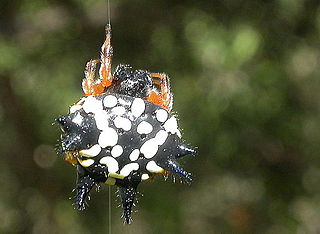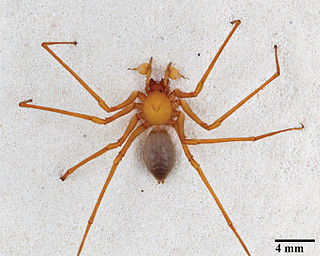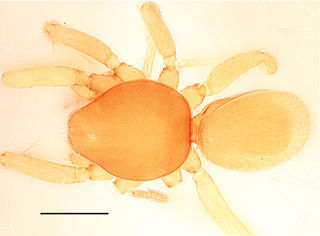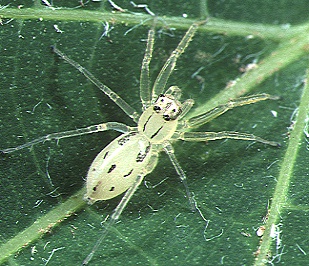
Austracantha is a genus of spider with a single species, Austracantha minax, commonly known as the jewel spider or the Christmas spider. It is a member of the family Araneidae and is endemic to Australia. They are relatively small spiders, reaching a maximum total body length of only around 12 mm (0.47 in) for females, and 5 mm (0.20 in) for males. Their abdomen has six distinctive projections ("spines") that makes them easy to identify. They are predominantly a shiny black, with variable white, yellow, and orange patterns. Melanistic forms also occur during autumn. They are facultatively gregarious, and can be found in large aggregations of overlapping orb webs. They feed on small flying insects that get entangled in their webs. They are harmless to humans, though the webs can be a nuisance for bushwalkers. They are most abundant during the summer months.

Tarantulas comprise a group of large and often hairy spiders of the family Theraphosidae. As of August 2022, 1,040 species have been identified, with 156 genera. The term "tarantula" is usually used to describe members of the family Theraphosidae, although many other members of the same infraorder (Mygalomorphae) are commonly referred to as "tarantulas" or "false tarantulas". Some of the more common species have become popular in the exotic pet trade. Many New World species kept as pets have setae known as urticating hairs that can cause irritation to the skin, and in extreme cases, cause damage to the eyes.

Trogloraptor is a genus of large spiders found in the caves of southwestern Oregon. It is the sole genus in the family Trogloraptoridae, and includes only one species, Trogloraptor marchingtoni. These spiders are predominantly yellow-brown in color with a maximum leg span of 3 in (7.6 cm). They are remarkable for having hook-like claws on the raptorial last segments of their legs.

Ozyptila trux, the yellow leaflitter crab spider, is a crab spider species with Palearctic distribution.

Bannana is a genus of goblin spiders native to Xishuangbanna prefecture, Yunnan Province, China, where it lives in the leaf-litter of tropical rainforest. There are two known species: Bannana crassispina and B. parvula, both described in 2015. Individuals are pale yellow and unpatterned, and range from around 1.0 to 1.8 mm in body length, with females being slightly larger than males. The eyes are reduced or entirely absent. Known only from a nature reserve in Xishuangbanna, Bannana belongs to a group of Asian goblin spiders known as the "Dysderoides complex", that ranges from China to Pakistan and south to Indonesia.
Carpathonesticus avrigensis is a species of araneomorph spider of the family Nesticidae. It occurs in Romania, where it was discovered in a cave. Only two specimens, a male and a female, are known.
Carpathonesticus fodinarum is a species of araneomorph spider of the family Nesticidae. It occurs in Romania, where it occurs in caves.
Carpathonesticus hungaricus is a species of araneomorph spider of the family Nesticidae. It occurs in Romania, where it inhabits caves.
Carpathonesticus ljovuschkini is a species of araneomorph spider of the family Nesticidae. It occurs in the Russian Caucasus. No male specimens have yet been described.
Carpathonesticus lotriensis is an araneomorph spider species of the family Nesticidae. It occurs in Romania, where it can be found in caves.
Carpathonesticus mamajevae is an araneomorph spider species of the family Nesticidae. It occurs in Georgia, in the Lagodekhi Nature Reserve.
Carpathonesticus paraavrigensis is a species of araneomorph spider of the family Nesticidae. It occurs in Romania, where it was discovered in a narrow gorge, on the overhanging side.
Carpathonesticus puteorum is a species of araneomorph spider of the family Nesticidae. It is found in the Romanian caves at an altitude of 460 to 930 m.
Carpathonesticus parvus is a species of araneomorph spider of the family Nesticidae. It occurs in Bosnia-Hercegovina, where it is found in caves. It was originally described from a single female specimen.
Carpathonesticus racovitzai is an araneomorph spider species of the family Nesticidae. It occurs in Romania, where it can be found both in caves and outdoors. It was transferred from the genus Nesticus to Carpathonesticus in 1982 by Weiss and Heimer.
Carpathonesticus simoni is an araneomorph spider species of the family Nesticidae. It occurs in Romania, where it can be found in caves. It was transferred from the genus Nesticus to Carpathonesticus in 1980 by Lehtinen and Saaristo.
Carpathonesticus spelaeus is an araneomorph spider species of the family Nesticidae. It occurs in Romania, where it can be found in caves and outdoors under calcareous blocks. It was transferred from the genus Nesticus to Carpathonesticus in 1980 by Lehtinen and Saaristo.

Avicularia juruensis is a species of spider in the family Theraphosidae, found in South America. Avicularia urticans was brought into synonymy in 2017. It has been given the English name Amazonian pink toe spider. Under the synonym Avicularia urticans, it is also known as the Peruvian pinktoe tarantula. It is a large mygalomorph spider, with a maximum body length over 30 mm (1.2 in) and the longest fully extended leg about 60 mm (2.4 in). Like other species in the genus Avicularia, specimens under this name are sold as pets, although their identity has not been confirmed by taxonomic studies.
Diminutella is a genus of spiders in the family Sparassidae. It was first described in 2018 by Rheims and Alayón. It is a monotypic genus with one described species, Diminutella cortina. It is endemic to Pinar del Rio, Cuba.

Asemonea tanikawai is a species of jumping spider in the genus Asemonea that is endemic to Japan. It lives in trees in mountain ranges. The spider was first described in 1996 by Hiroyoshi Ikeda. The spider is small, with a carapace [prosoma that between 1.31 and 1.60 mm long and an abdomen is between 1.84 and 2.24 mm long. It is whitish-yellow with a pattern of two brown stripes down the back of the carapace and nine black dots on the back of the abdomen. The male has a distinctive pedipalp with a complex tibial apophysis and a furrow alongside the femoral apophysis, which distinguishes it from the otherwise similar Asemonea maculata and Asemonea pinangensis. The female is also similar, with its copulatory openings hidden in its epigyne. The spider has been found throughout Okinawa and the other Ryukyu Islands.






